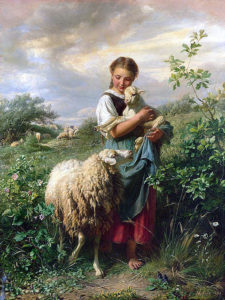Anna Groff began as executive director of Dove’s Nest on August 1. She works from her home in Tucson, Arizona, where she lives with her husband, Brian Miller, and one-year-old daughter, Ella.
I am aware that some families and religious groups use the Bible to justify — even encourage — corporal punishment.
In fact, according to the 2012 General Social Survey, 80 percent of born-again Christians say spanking is okay.
These individuals may refer to passages in Proverbs, such as “Those who spare the rod of discipline hate their children. Those who love their children care enough to discipline them” (13:24) or “A youngster’s heart is filled with foolishness, but physical discipline will drive it far away” (22:15).
Personally, I am tempted to simply ignore these passages as less than helpful advice that doesn’t apply to our modern times or chalk it up as a part of the Bible that we can’t quite understand and move on. Or, as Jonathan Merritt wrote in the Week in 2014, “Outside of this passage … the Bible barely says anything about physical punishment of children … There are none — count ’em, zero — verses in the New Testament endorsing spanking.”
But if we dig deeper, our understanding can shift and offer new insights into parenting and discipline.
Caring for our children is not about throwing out the rod, but understanding what the term “rod” might mean.
In Jeanette Harder’s book Let the Children Come: Preparing Faith Communities to End Child Abuse and Neglect, she explains another definition of “rod.” “The rod spoken in both Proverbs and Psalms is actually the rod used by shepherds to care for their sheep in biblical times,” Harder writes.
The Hebrew word for rod is shebet, and it is a tool specifically used for the following purposes:
- To throw in front of wandering sheep to bring them back to the flock 2. To count the sheep
- To scare off an intruding animal and protect the sheep
- To part the sheep’s wool to examine the skin for disease
- To symbolize the guardianship of a shepherd over the sheep
This rod is not about harm or punishment, instead it is about keeping sheep in the fold and nurturing them. “The point of discipline is to transmit values to children. The purpose of punishment is to coerce compliance and secure control, and failing that, to inflict pain as a form of revenge, a realm the Bible says belongs to God alone,” writes Michael Eric Dyson in the New York Times.
I find peace in imagining God’s love for me as a Shepherd looking out for God’s sheep.
The calling of the church and parents is to love and protect their children in the same way.
One very real way to do this is to create and implement child protection policies in faith community settings. Early in my role with Dove’s Nest, I was told that if people say that creating a policy is going to be easy or will come about without differences in opinions, they are wrong. Usually, something comes up and some kind of conflict rises in unexpected ways. For one thing, we often agree that we want a policy, but we aren’t sure how to hold individuals accountable to it. Or—for some of us—the term “policy” is like the term “rod.” We misunderstand it and maybe we even bristle slightly when we hear it—or when we consider the work involved with a protection policy.
Instead of seeing a policy as a list of impractical rules or barriers for volunteers eager to work with children, let’s see it as a “rod” that provides comfort and safe boundaries to children.
First, the protection policy—or rod—helps us know where our children are and what they are doing when they are in our care.
Second, a policy helps to keep predators away. It demonstrates to families with young children (or any vulnerable individuals) that church is not a free-for-all but rather a place where children are watched over closely and protected from harm.
Third, it enables us as teachers and volunteers to be aware of signs of child abuse and neglect and how to report them.
Finally, it can offer a symbol of our priority to love and protect children, as Christ did. The terms “rod” or “policy” can be turnoffs, but if we take the time to dig deeper and reflect on this, we may come up with some creative new ways of approaching the way we care for children. Let’s find ways to support one another as we implement new policies, dust off old ones, or revisit practices.
Always know that Dove’s Nest is available as a resource to your congregation.
We offer support in creating and implementing child protection policies, ways to help the children and young families in your church and community, training on teaching the Circle of Grace curriculum, and much more.


